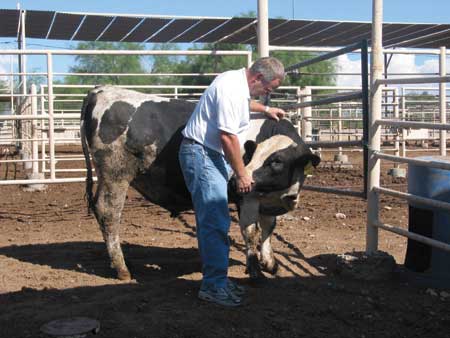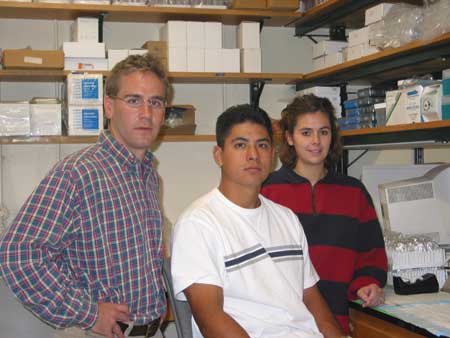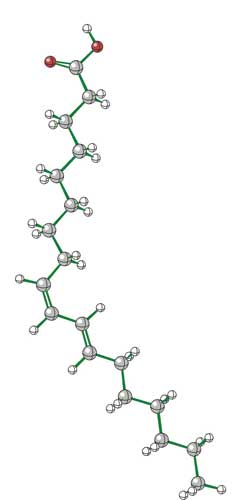Improving Meat Quality with CLA
Fatty acid benefits animal and human health
2003
Arizona Agricultural Experiment Station Research Report
![]()
Written by
Susan McGinley
Conjugated linoleic acid (CLA) isn’t yet a household term, but it likely will be. A naturally occurring polyunsaturated fatty acid found almost exclusively in the milk and meat fat of ruminants such as cattle, sheep and goats, CLA offers benefits for both animal and human health. Studies in experimental models have shown that CLA protects animals against cancer, diabetes and heart disease, decreases the animal’s body fat, stimulates the immune system and bone development, alleviates wasting disease and eases symptoms of lupus. The substance has not yet been extensively evaluated in human trials.
“As a consequence of its biological effects and origin, CLA has
received considerable attention from not only the medical community and
human nutritionists, but also animal scientists,”says Lance Baumgard,
assistant professor of animal sciences in the University of Arizona College
of Agriculture and Life Sciences.
Baumgard and colleagues Glenn Duff, Darrell Goll, Ron Allen and graduate student Octavio Mendivil are investigating ways of increasing the CLA content of adipose tissue in cattle to improve meat quality in natural and conventionally raised beef. What they find may not only help Arizona’s beef industry, but also provide a greater understanding of how CLA operates to protect and improve animal health.

Glenn Duff, associate professor, with Holstein steer “Irwin” at the UA Campus Agricultural Center feedlot.
In a feeding study focused on body composition, the research team aims
to increase lean tissue in beef cattle while decreasing the fat content
in the right places.
“Fat is deposited in three places in beef cattle,” Duff says. “There’s backfat, internal fat, and marbling. We want to decrease the first two while leaving the third alone, to increase the quality of the meat.” CLA content in meat and milk can be improved by altering feed rations, including changes in the ratio of forage to grain concentrates, and by adding different types and levels of polyunsaturated oils.
In two trials with 30 cattle in 2001 and 20 in 2002, the researchers
put half the animals on a diet with CLA in the feed, and half on a control
diet. (The animals were from the UA’s V Bar V Ranch). The CLA they
fed the animals was chemically synthesized in a laboratory, although it
can also be obtained from animal fat. Each animal received infusions of
insulin, epinephrine (adrenalin) and glucose and was monitored for the
way it handled these substances metabolically and hormonally.
Mendivil has collected blood from the cattle at selected times and analyzed
it for different concentrations of non-essential fatty acids and glucose.
He uses a gas chromatograph to analyze fat samples for fatty acid content.
So far the team has demonstrated that supplementing dietary CLA in beef
cattle can increase the CLA content of adipose tissue by more than four-fold,
but questions regarding the implications of that change still need to
be studied.
“We believe the animals on CLA will react in a way that increases muscle synthesis and decreases fat synthesis,” Baumgard says. He hopes this will ultimately increase the healthiness of meat and milk products and improve carcass value, feed efficiency and the health and well-being of the animal.
The next trial will target muscle and fat composition in a production
situation, using Holstein steers from a cooperator in Arizona and the
same CLA feeding regime. Holsteins comprise the majority of the state’s
approximately 300,000 head of feedlot cattle.
“They will be fed diets typical of those administered in feedlots across the state, with CLA given to half the group,” Duff says. “During feeding we’ll be looking at the performance of the cattle, including average daily gain, feed intake and feed efficiency. We’ll also look at the carcasses for total meat yield, the size of the rib-eye area including the amount of muscle versus fat, fat thickness, the amount of internal or gut fat (waste), and quality grades—select, choice and prime—reflected in marbling.” Approximately 60 to 80 percent of Arizona beef is designated choice grade, depending on management programs.
“We want to improve the percentage of calves that grade choice without sacrificing performance,” Duff says. “This could potentially change the diet at the feedlots.” Once CLA has been proven to be effective in improving meat quality—and the researchers believe it will—they will make sure it’s cost-effective to the producer. CLA is so new that it is not commercially available as an animal feed component; the researchers have been using a preliminary study formulation and will have to develop a realistic cost analysis for producers.
“If it works the way we think it does there are probably at least
two or three more years of testing to make sure CLA supplements are beneficial,
effective and cost-efficient,” Baumgard says. Feeding regimens need
to be developed, including dosages and timing for growth stages. Meat
quality resulting from increased dietary CLA must be determined, including
effects on marbling, taste, tenderness, color and other factors.
In a related study Baumgard and Duff are analyzing the effects of dietary
CLA on growth performance in castrated beef cattle. They hypothesize that
“feeding this supplement will prevent the reduced rates of gain that
immediately follow castration and thus improve economic return for the
Arizona beef industry.”
"There is substantial interest in the medical community to utilize CLA as a therapeutic nutrient or at least as a preventative dietary agent for many common human diseases,”Baumgard says. “At the very least, we believe CLA will have a strong positive effect on public perception of animal foodstuffs.”

Lance Baumgard, assistant professor, with graduate student Octavio Mendivil and research specialist Sara Sanders in Department of Animal Sciences laboratory.
 |
CONJUGATED LINOLEIC ACID (CLA) Beyond obvious vitamin and mineral properties, recent evidence
shows that foods that have been around for millenia have other factors
that improve health. Tomatoes contain lycopene, grapes have anthocyanins,
and broccoli features cancer-fighting sulfides. For at least a decade
scientists have known that conjugated linoleic acid found in ruminant
animals contains one of the most potent anti-carcinogens ever discovered,
according to Lance Baumgard, UA animal scientist. “It decreases tumor formation, and is toxic to existing tumors,” he says. It’s preventative and therapeutic, and is not destroyed by cooking. CLA affects Type II diabetes, fat synthesis, lupus, atherosclerosis and immune system function. It’s a remarkable molecule.” |
CONTACT:
Lance Baumgard
(520) 621-1487
baumgard@ag.arizona.edu
Glenn Duff
(520) 626-5573
gduff@ag.arizona.edu
Return to the Title Page
Return to the Table of Contacts
The University of Arizona is an Equal Opportunity/Affirmative
Action Employer. Any products, services, or organizations that are mentioned,
shown, or indirectly implied in this publication do not imply endorsement
by the University of Arizona.
Published January 2004
Return to College publication list